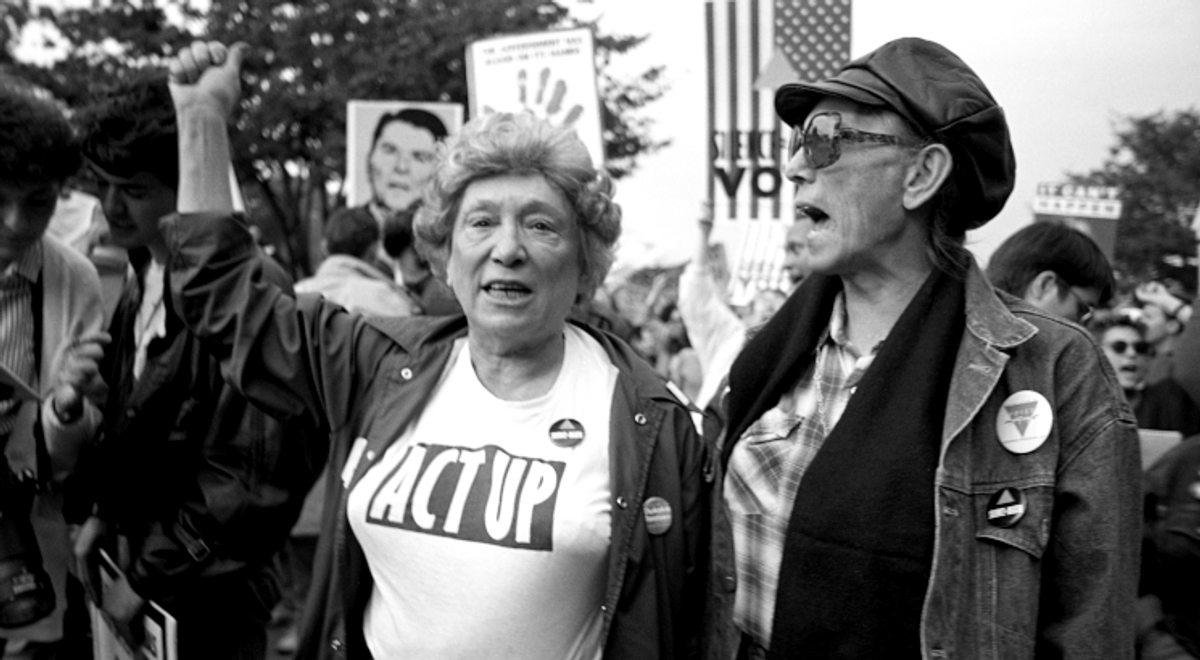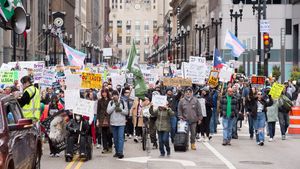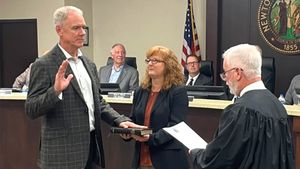The accomplishments of the direct-action HIV organization ACT UP are staggering.
Over the course of six years, from 1987 to 1993, ACT UP designed a fast-track system where those who were sick could access unapproved experimental drugs, ran a four-year campaign to force the Centers for Disease Control and Prevention to change its definition of those at risk for AIDS to include women, made needle exchange legal in New York City, started Housing Works, a service for homeless people with HIV that exists to this day, ended insurance exclusion for people with AIDS, reconceptualized what effective treatment looks like, and in the process redefined how the world thought about people with HIV and the larger LGBTQ+ community.
But how did ACT UP do it?
Let the Record Show: A Political History of ACT UP New York, 1987-1993, the new book by historian Sarah Schulman, explores just that. Drawing from 188 interviews with surviving ACT UP members, Let the Record Show is an utterly crucial guidebook for effective activism.
You can listen to Schulman discuss the history of ACT UP on the LGBTQ&A podcast (available on Apple Podcasts and Spotify) and read an excerpt below.
In the book, I was struck by how massive and complex of an organization ACT UP was. Is it a common misunderstanding that the group was just a small group of people?
The whole history of AIDS and AIDS activism has been narrowed and whitewashed down to a handful of individuals. So this is the first really accurate history. One of the great successes of the movement is that it was so flexible. It didn’t work on consensus. There was simultaneity of response. And it was a real coalition.
What it really is, is little silos of groups of like-minded people working together on things that really matter to them in an effective way. And those different groups standing side by side and trading in and out and supporting each other’s projects. That was the open structure, the radical democracy of ACT UP.
You write that 500-800 people would show up to the Monday meetings and the biggest action drew about 7,000 people.
Yes, but that’s actually quite small when you think about it, because mass movements or very effective movements have hundreds of thousands of people, but this was really more like a vanguard movement.
How did you ever get anything accomplished in a meeting with 500-800 people?
Most of what was accomplished was not accomplished in the meeting itself. It was accomplished in these small groups called affinity groups that had 10 to 20 people who would meet separately from the Monday night meetings and would plan actions. So the Monday night meeting was just a gathering of all of these different functional entities that were doing their own projects at the same time.
Was there an approval process for affinity groups who wanted to execute an action?
Affinity groups were not accountable to the Monday night meeting; they would plan often illegal or civil disobedience actions to support larger actions that the group was officially organizing, but they worked privately. And the larger group did provide legal support for them. But there was no consensus in ACT UP. The only point of unity was direct action to end the AIDS crisis, that’s it. So that meant you couldn’t be doing social service provision, for example; it had to be direct action, and it had to be to end the AIDS crisis.
If you were doing those two things, you could really do anything. The group did not have to all agree. For example, if you wanted to do needle exchange on the Lower East Side to provoke an arrest for a test case, and if I thought that was a terrible idea, I wouldn’t try to stop you from doing it. I just wouldn’t do it. If instead I wanted to interrupt Mass at St. Patrick’s Cathedral, and you were against that, you just wouldn’t go.
And it was understood by all members that there wouldn’t be consensus on everything?
No, because ACT UP never theorized itself. So it just evolved that way, without any sort of discussion. There was very little theory in ACT UP. And as Maxine Wolfe said, “Theory emerges from action.” So if you put action first, then you have to make decisions about how to do your action. And that’s where your values come to surface. But if you’re debating theory before you act, you’ll end up in very polarized positions, and you won’t have anything on the table.

Another misconception is that Larry Kramer was the sole creator and leader of ACT UP. You write that he was influential but not in charge.
No, I interviewed 188 surviving members of ACT UP, and not one person considered Larry Kramer to be the leader of ACT UP.
ACT UP in its time was represented inaccurately in the media. Because when we go back to the ’80s, we have to remember that media, government, and private corporate life were all controlled by white males. And gay men among those white males were closeted. It’s nothing like it is now.
So the white male media would come to ACT UP, and they would only see white men, they would interview white men, they would use photographs of white men. Other people were there doing things, but it wouldn’t be covered. And this was debated openly. I had a public conversation with Larry Kramer at OutWrite, which was the gay and lesbian writers’ conference, in 1990. And I said, “Well, Larry, what about the next time the media calls you? Why don’t you pass them on to a woman or person of color in ACT UP?” And he said, “But Sarah, should we use our best people?” So there was this kind of sifting going on. And it’s only when you look at ACT UP’s own media that you actually see a more accurate representation.
Media during this time liked to portray people with AIDS as male-only and in hospital beds. Women were only seen as caretakers, not people on the front lines or who could also get AIDS.
That’s a complete distortion. That’s a sexist distortion. My interviews show that there was no gender differential in terms of who was a caretaker in ACT UP. Men and women were both caretakers and activists.
Donna Binder is a very important person in this whole story. And I’m happy to introduce her to history. She was a photographer-journalist who was photographing ACT UP. In those days, you’d go home to your darkroom, develop the photos, and you’d physically take them to the photo editors at Time magazine or U.S. News & World Report or whatever. And she would be bringing in these photos and they’d say, “No, we want people with AIDS. We want people who are emaciated, covered with [Kaposi’s sarcoma lesions], lying in bed.” And she would say, “These are people with AIDS.”
And finally, after ACT UP disrupted Mass at St. Patrick’s Cathedral in 1989, they turned around and they started wanting activist photos. But it’s really about the individual who’s up against the institution. Having that conversation with the person in power, sometimes jeopardizing their own ability to earn a living, and it helps people change their minds.
Listen to the full podcast interview on Apple Podcasts or Spotify.
Let The Record Show comes out May 18.
LGBTQ&A is The Advocate's weekly interview podcast hosted by Jeffrey Masters. Past guests include Pete Buttigieg, Laverne Cox, Cleve Jones, and Roxane Gay. Episodes come out every Tuesday.


















































































